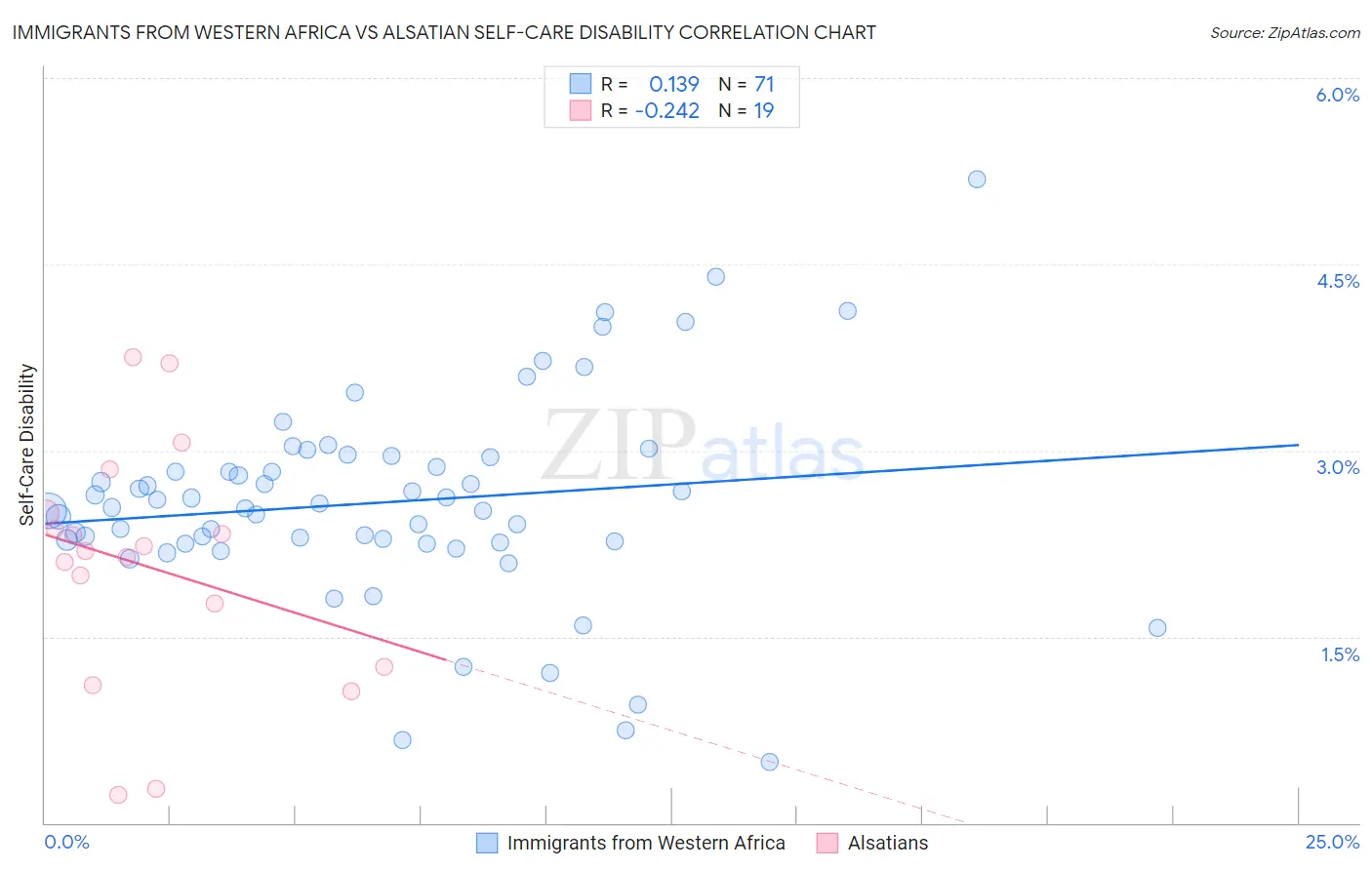Immigrants from Western Africa vs Alsatian Self-Care Disability
COMPARE
Immigrants from Western Africa
Alsatian
Self-Care Disability
Self-Care Disability Comparison
Immigrants from Western Africa
Alsatians
2.5%
SELF-CARE DISABILITY
13.3/ 100
METRIC RATING
200th/ 347
METRIC RANK
2.4%
SELF-CARE DISABILITY
94.9/ 100
METRIC RATING
103rd/ 347
METRIC RANK
Immigrants from Western Africa vs Alsatian Self-Care Disability Correlation Chart
The statistical analysis conducted on geographies consisting of 357,358,098 people shows a poor positive correlation between the proportion of Immigrants from Western Africa and percentage of population with self-care disability in the United States with a correlation coefficient (R) of 0.139 and weighted average of 2.5%. Similarly, the statistical analysis conducted on geographies consisting of 82,671,639 people shows a weak negative correlation between the proportion of Alsatians and percentage of population with self-care disability in the United States with a correlation coefficient (R) of -0.242 and weighted average of 2.4%, a difference of 5.9%.

Self-Care Disability Correlation Summary
| Measurement | Immigrants from Western Africa | Alsatian |
| Minimum | 0.50% | 0.22% |
| Maximum | 5.2% | 3.7% |
| Range | 4.7% | 3.5% |
| Mean | 2.6% | 2.1% |
| Median | 2.5% | 2.2% |
| Interquartile 25% (IQ1) | 2.3% | 1.3% |
| Interquartile 75% (IQ3) | 3.0% | 2.5% |
| Interquartile Range (IQR) | 0.69% | 1.2% |
| Standard Deviation (Sample) | 0.83% | 0.97% |
| Standard Deviation (Population) | 0.82% | 0.94% |
Similar Demographics by Self-Care Disability
Demographics Similar to Immigrants from Western Africa by Self-Care Disability
In terms of self-care disability, the demographic groups most similar to Immigrants from Western Africa are Immigrants from South Eastern Asia (2.5%, a difference of 0.030%), Slovak (2.5%, a difference of 0.070%), Immigrants from Lebanon (2.5%, a difference of 0.090%), Immigrants from Ghana (2.5%, a difference of 0.14%), and Immigrants from Bahamas (2.5%, a difference of 0.14%).
| Demographics | Rating | Rank | Self-Care Disability |
| Ukrainians | 21.4 /100 | #193 | Fair 2.5% |
| Immigrants | Germany | 17.9 /100 | #194 | Poor 2.5% |
| Immigrants | Southern Europe | 15.6 /100 | #195 | Poor 2.5% |
| Koreans | 15.5 /100 | #196 | Poor 2.5% |
| Crow | 15.2 /100 | #197 | Poor 2.5% |
| Immigrants | Immigrants | 15.0 /100 | #198 | Poor 2.5% |
| Immigrants | Ghana | 14.7 /100 | #199 | Poor 2.5% |
| Immigrants | Western Africa | 13.3 /100 | #200 | Poor 2.5% |
| Immigrants | South Eastern Asia | 12.9 /100 | #201 | Poor 2.5% |
| Slovaks | 12.6 /100 | #202 | Poor 2.5% |
| Immigrants | Lebanon | 12.4 /100 | #203 | Poor 2.5% |
| Immigrants | Bahamas | 11.9 /100 | #204 | Poor 2.5% |
| Immigrants | Russia | 11.0 /100 | #205 | Poor 2.5% |
| Alaskan Athabascans | 10.4 /100 | #206 | Poor 2.5% |
| French | 9.9 /100 | #207 | Tragic 2.5% |
Demographics Similar to Alsatians by Self-Care Disability
In terms of self-care disability, the demographic groups most similar to Alsatians are Croatian (2.4%, a difference of 0.030%), Bhutanese (2.4%, a difference of 0.10%), Carpatho Rusyn (2.4%, a difference of 0.13%), Immigrants from Indonesia (2.4%, a difference of 0.14%), and British (2.4%, a difference of 0.15%).
| Demographics | Rating | Rank | Self-Care Disability |
| Immigrants | Chile | 96.7 /100 | #96 | Exceptional 2.4% |
| Swiss | 96.6 /100 | #97 | Exceptional 2.4% |
| Immigrants | Poland | 96.4 /100 | #98 | Exceptional 2.4% |
| Immigrants | Israel | 96.1 /100 | #99 | Exceptional 2.4% |
| Europeans | 95.8 /100 | #100 | Exceptional 2.4% |
| Immigrants | Scotland | 95.7 /100 | #101 | Exceptional 2.4% |
| Croatians | 95.0 /100 | #102 | Exceptional 2.4% |
| Alsatians | 94.9 /100 | #103 | Exceptional 2.4% |
| Bhutanese | 94.5 /100 | #104 | Exceptional 2.4% |
| Carpatho Rusyns | 94.4 /100 | #105 | Exceptional 2.4% |
| Immigrants | Indonesia | 94.3 /100 | #106 | Exceptional 2.4% |
| British | 94.3 /100 | #107 | Exceptional 2.4% |
| Greeks | 94.1 /100 | #108 | Exceptional 2.4% |
| Slovenes | 94.1 /100 | #109 | Exceptional 2.4% |
| Immigrants | Africa | 93.7 /100 | #110 | Exceptional 2.4% |